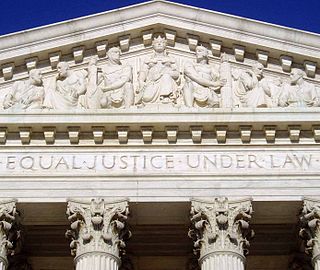
In the United States, a state court has jurisdiction over disputes with some connection to a U.S. state. State courts handle the vast majority of civil and criminal cases in the United States; the much smaller in case load and personnel, United States federal courts, handle different types of cases.
In common law systems, a superior court is a court of general competence which typically has unlimited jurisdiction with regard to civil and criminal legal cases. A superior court is "superior" relative to a court with limited jurisdiction, which is restricted to civil cases involving monetary amounts with a specific limit, or criminal cases involving offenses of a less serious nature. A superior court may hear appeals from lower courts.
The original jurisdiction of a court is the power to hear a case for the first time, as opposed to appellate jurisdiction, when a higher court has the power to review a lower court's decision. Original jurisdiction refers to the right of the Supreme court to hear a case for the first time. It has the exclusive right to hear all cases that deal with disputes between states, or between states and the union government. It also has original jurisdiction over cases brought to the court by ordinary people regarding issues to the importance of society at large.
The Judiciary of Colorado is established and authorized by Article VI of the Colorado Constitution as well as the law of Colorado. The various courts include the Colorado Supreme Court, Colorado Court of Appeals, Colorado district courts, Colorado county courts, Colorado water courts, and municipal courts. The administration of the state judicial system is the responsibility of the Chief Justice of the Colorado Supreme Court as its executive head, and is assisted by several other commissions. In Denver, the county and municipal courts are integrated and administratively separate from the state court system.

The Philadelphia Municipal Court is a trial court of limited jurisdiction seated in Philadelphia, Pennsylvania. It has 27 judges elected by the voters of Philadelphia. The Municipal Court has three divisions: the Criminal Division, the Civil Division, and the Traffic Division. Within the Unified Judicial System of Pennsylvania, it serves as a substitute for the magisterial district courts that serve the rest of the Commonwealth. It is a part of the First Judicial District of Pennsylvania.
The government of New Mexico is the governmental structure of the state of New Mexico as established by the Constitution of New Mexico. The executive is composed of the Governor, several other statewide elected officials and the Governor's cabinet. The New Mexico Legislature consists of the House of Representatives and Senate. The judiciary is composed of the New Mexico Supreme Court and lower courts. There is also local government, consisting of counties, municipalities and special districts.
In Washington, there are several different state courts. Judges are elected and serve four-year or six-year terms. Most judges first come to office when the governor of Washington appoints them after a vacancy is created - either by the death, resignation, retirement, or removal of a sitting judge, or when a new seat on the bench is created by the Washington State Legislature.
The Judiciary of Vermont is the state court system of Vermont, charged with Vermont law.

The Judiciary of New York is the judicial branch of the Government of New York, comprising all the courts of the State of New York
In the Nevada state court system, the Nevada District Courts are the trial courts of general jurisdiction, where criminal, civil, family, and juvenile matters are generally resolved through arbitration, mediation, and bench or jury trials.
The Unified Judicial System of Pennsylvania is the unified state court system of the Commonwealth of Pennsylvania.

The Massachusetts District Court is a trial court in Massachusetts that hears a wide range of criminal, civil, housing, juvenile, mental health, and other types of cases.
The government of North Carolina is divided into three branches: executive, legislative, and judicial. These consist of the Council of State, the bicameral legislature, and the state court system. The Constitution of North Carolina delineates the structure and function of the state government.
The government of the State of Washington is the governmental structure of the State of Washington as established by the Constitution of the State of Washington. The executive is composed of the Governor, several other statewide elected officials and the Governor's cabinet. The Washington State Legislature consists of the House of Representatives and State Senate. The judiciary is composed of the Washington Supreme Court and lower courts. There is also local government, consisting of counties, municipalities and special districts.
The Judiciary of Virginia is defined under the Constitution and law of Virginia and is composed of the Supreme Court of Virginia and subordinate courts, including the Court of Appeals, the Circuit Courts, and the General District Courts. Its administration is headed by the Chief Justice of the Supreme Court, the Judicial Council, the Committee on District Courts, the Judicial Conferences, the Judicial Inquiry and Review Commission, and various other offices and officers.

The Judiciary of Louisiana is defined under the Constitution and law of Louisiana and is composed of the Louisiana Supreme Court, the Louisiana Circuit Courts of Appeal, the District Courts, the Justice of the Peace Courts, the Mayor's Courts, the City Courts, and the Parish Courts. The Chief Justice of the Louisiana Supreme Court is the chief administrator of the judiciary, and its administration is aided by the Judiciary Commission of Louisiana, the Louisiana Attorney Disciplinary Board, and the Judicial Council of the Supreme Court of Louisiana.
The Judiciary of Michigan is defined under the Michigan Constitution, law, and regulations as part of the Government of Michigan. The court system consists of the Michigan Supreme Court, the Michigan Court of Appeals as the intermediate appellate court, the circuit courts and district courts as the two primary trial courts, and several administrative courts and specialized courts. The Supreme Court administers all the courts. The Michigan Supreme Court consists of seven members who are elected on non-partisan ballots for staggered eight-year terms, while state appellate court judges are elected to terms of six years and vacancies are filled by an appointment by the governor, and circuit court and district court judges are elected to terms of six years.
Inferior courts in Montana, also known as courts of limited jurisdiction, refer to those courts of law, established by the Constitution of Montana or authorized by law, with limited jurisdictions. These courts consist of City Courts, Justice Courts, and Municipal Courts. Inferior courts may be courts of record, or they may not. Appeals from inferior courts are made to Montana District Courts.
Magistrate judge, in U.S. state courts, is a title used for various kinds of judges, typically holding a low level of office with powers and responsibilities more limited than state court judges of general jurisdiction.
The Nevada Judiciary is the judicial branch of the Government of Nevada, which is responsible for applying the Constitution and law of Nevada. It consists of the Supreme Court, Court of Appeals, district courts, justice courts, and municipal courts. The Supreme Court oversees the administration of the judiciary.







